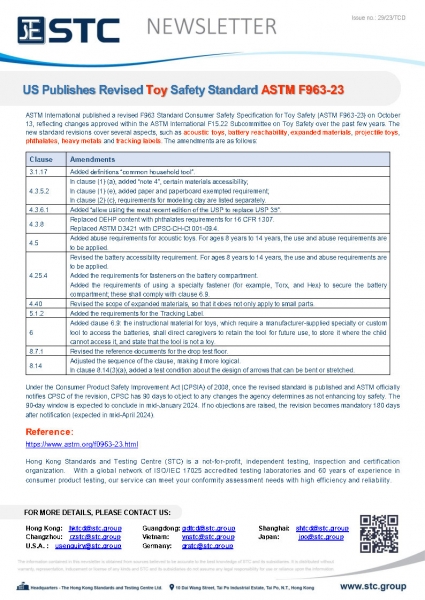
US Publishes Revised Toy Safety Standard ASTM F963-23
ASTM International published a revised F963 Standard Consumer Safety Specification for Toy Safety (ASTM F963-23) on October 13, reflecting changes approved within the ASTM International F15.22 Subcommittee on Toy Safety over the past few years. The new standard revisions cover several aspects, such as acoustic toys, battery reachability, expanded materials, projectile toys, phthalates, heavy metals and tracking labels. The amendments are as follows:
|
Clause |
Amendments |
|
3.1.17 |
Added definitions “common household tool”. |
|
4.3.5.2 |
In clause (1)(a), added “note 4”, certain materials accessibility; In clause (1)(e), added paper and paperboard exempted requirement; In clause (2)(c), requirements for modeling clay are listed separately. |
|
4.3.6.1 |
Added “allow using the most recent edition of the USP to replace USP 35”. |
|
4.3.8 |
Replaced DEHP content with phthalates requirements for 16 CFR 1307. Replaced ASTM D3421 with CPSC-CH-C1001-09.4. |
|
4.5 |
Added abuse requirements for acoustic toys. For ages 8 years to 14 years, the use and abuse requirements are to be applied. |
|
4.25.4 |
Revised the battery accessibility requirement. For ages 8 years to 14 years, the use and abuse requirements are to be applied. Added the requirements for fasteners on the battery compartment. Added the requirements of using a specialty fastener (for example, Torx, and Hex) to secure the battery compartment; these shall comply with clause 6.9. |
|
4.40 |
Revised the scope of expanded materials, so that it does not only apply to small parts. |
|
5.1.2 |
Added the requirements for the Tracking Label. |
|
6 |
Added clause 6.9: the instructional material for toys, which require a manufacturer-supplied specialty or custom tool to access the batteries, shall direct caregivers to retain the tool for future use, to store it where the child cannot access it, and state that the tool is not atoy. |
|
8.7.1 |
Revised the reference documents for the drop test floor. |
|
8.14 |
Adjusted the sequence of the clause, making it more logical. In clause 8.14(3)(a), added a test condition about the design of arrows that can be bent or stretched. |
Under the Consumer Product Safety Improvement Act (CPSIA) of 2008, once the revised standard is published and ASTM officially notifies CPSC of the revision, CPSC has 90 days to object to any changes the agency determines as not enhancing toy safety. The 90-day window is expected to conclude in mid-January 2024. If no objections are raised, the revision becomes mandatory 180 days after notification (expected in mid-April 2024).
Reference:
https://www.astm.org/f0963-23.html
Hong Kong Standards and Testing Centre (STC) is a not-for-profit, independent testing, inspection and certification organization. With a global network of ISO/IEC 17025 accredited testing laboratories and 60 years of experience in consumer product testing, our service can meet your conformity assessment needs with high efficiency and reliability.










